Introduction
Florida-Friendly Landscaping™ (FFL) is Florida's premier Extension program for ecologically sustainable, science-based landscape practices that protect water resources. Since its beginning in the early 1990s, the FFL program has provided water resource protection through both water conservation (water savings) and reducing pollutants (fertilizer nitrogen and phosphorus; pesticides) that may otherwise run off or leach into the state’s water bodies.
The FFL program’s public outreach messaging is centered on 9 FFL principles that promote sustainable landscape design, proper irrigation system design and operation, and protocols that minimize or eliminate the need for fertilizers and pesticides. One of these basic principles, FFL Principle No. 4, promotes the proper use of sustainably sourced mulch as a way to retain soil moisture, control weed growth, and discourage insect pests and plant pathogens. This publication is intended for those persons seeking information on how to properly select and use mulch as one component of a Florida-friendly landscape design.
The Benefits of Mulch
Mulch provides functionality, serving as the border between the lawn and landscape bed or next to walks and driveways. Mulch acts as a buffer that can be placed around the base of trees and shrubs to prevent mower and trimmer damage. It also adds value and curb appeal to residential properties, such as with the use of fine and coarse aggregate textures or contrasting colors.
Placing mulch around trees, shrubs, and planted beds provides many Florida-friendly benefits. In areas difficult to mow, irrigate, or otherwise maintain, use a mulch to replace turf or other plants. Also, consider placing mulch in shady areas where turfgrass may struggle. Mulch is also a nice aesthetic addition to gardens and landscapes and helps to tie the landscape together.
Reduced Weed Germination and Control. Putting down a 2”–3" layer of coarse and/or less nutrient-rich mulch is a highly effective way of controlling weed germination and growth. Mulch prevents light from penetrating to seedlings and stresses existing weeds. This benefit wanes as mulch breaks down but will return as mulch is refreshed.
Some organic mulches, especially certain types of wood chips, can control weeds through emission of allelopathic, or growth-inhibiting, chemicals naturally occurring in the wood. Pine and eucalyptus mulches are able to suppress germination of several common weed species. Water extracts of these materials also supported an allelopathic function (Chalker-Scott 2007).
Seed Germination and Seedling Survival. Many controlled studies show that mulch improves seed germination and seedling survival in woody and herbaceous plants (Chalker-Scott 2007). A thin layer of organic mulch increases seedling emergence and survival. However, the thin amount of organic mulch applied to help seedlings survive may not be thick enough to stifle weeds because the layer over seedlings must be thinner than that necessary for weed control.
Root Growth, Transplantation, and Plant Performance. Roots covered in mulch expand far past the trunk compared to bare soil, stabilizing the plant. Root establishment increases the chances that the plant will survive. Mulch has also been shown to help plants survive transplanting in harsh conditions.
Many studies have shown that organic mulches allow trees, shrubs, and other plants to thrive. Researchers have found that a mulched tree grows 67% better than one planted in bare soil. Increases in plant height, stem and trunk diameter, leaf size and number, and flower, fruit and or seed production have all been shown to improve with the use of mulch. Chalker-Scott (2007) also notes that gravel and stone are not as effective as organic mulches in overall optimization of plant performance.
Disease Control. Mulch helps maintain soil moisture, slowing evaporation and reducing plants' water needs. It moderates soil temperature by keeping plant roots warmer in winter and cooler in summer. Organic mulches help gradually build soil organic matter as it decomposes and improves nutrient-holding capacity and available nutrients for landscape plants. All these factors indirectly provide the optimal environment for healthy plants to grow, indirectly lowering the plants susceptibility to succumb to pathogens. Finally, mulch reduces the likelihood of contact damage from trimmers and mowers, which can cause wounds on trunks and branches.
Research has shown that organic mulches promote soil health, that is, they support a diverse community of soil organisms. However, a healthy soil also promotes the diversity of beneficial microbes and insects in the larger landscape (Chalker-Scott 2007). A diverse community of beneficial soil organisms in a healthy, mulched soil can provide ecological services such as resource competition, enzymatic breakdown, and chemical inhibition functions that can help to biologically control many plant pathogens and the diseases they cause.
Mulch Types
Mulch is available in two primary forms, organic and inorganic. Organic mulch is a naturally renewable resource sourced as a by-product from the lumber-milling industry, land clearing, invasive control programs, county and municipal waste collection, and controlled, renewable planting on plantations. Organic mulches facilitate a vital role in retaining soil moisture, providing an environment for beneficial soil bacteria, maintaining and cycling soil organic matter, and creating an aesthetically pleasing landscape—all of which are Florida-friendly mulch functions. Organic mulches can also be acquired naturally from pine forest and composted yard debris. Except for cypress, organic mulches are mostly Florida-friendly.
Inorganic mulches can still be made from natural materials such as pebbles or rocks, but they are also sometimes made of manufactured materials, such as ground rubber tires. Inorganic mulches are not considered Florida-friendly because they don’t contribute to wildlife habitat or soil health, and they often make the roots underneath the mulch too hot.
Many types and sources of mulches are readily available. A variety of these are discussed below and summarized in Table 1.
- Utility mulch—Utility mulch is often sold or provided for free by utility companies or tree services that are clearing branches from utility lines or removing trees. Utility mulch may contain weed seeds, leaves, and dirt, so it may not be appropriate for vegetable or ornamental gardens but may be used in walkways and natural areas.
- Pine bark—Pine bark mulch is a by-product of the forest industry and comes either ground or in nugget form.Dark brown in color, it settles more slowly than utility mulch, eucalyptus, and pine straw mulches, with two-thirds of the original mulch still maintained after two years. Pine bark mulch durability is matched by cedar and beaten only by melaleuca (Duryea and Minogue 2017).
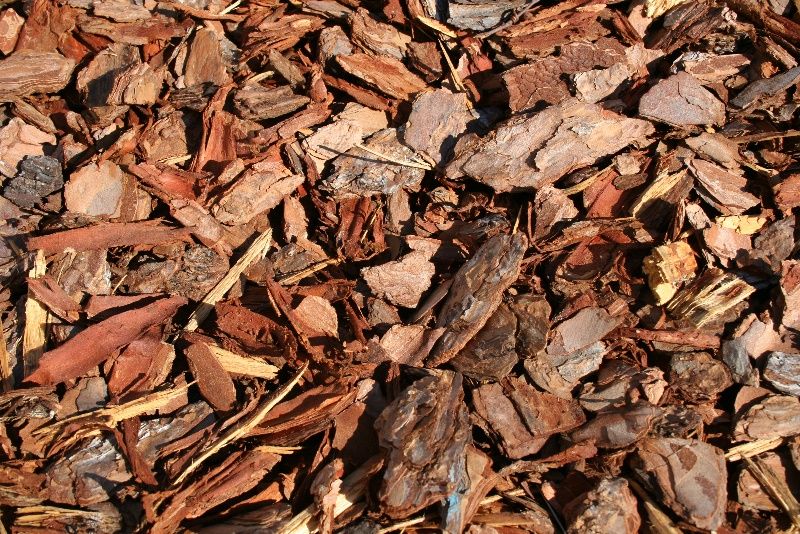
Credit: Florida-Friendly Landscaping™
- Pine straw—Pine straw (or pine needles) comes from plantations producing paper and wood products. It is raked up and bundled or rolled. Pine straw stays in place as the needles knit together to form mats on the ground. It creates a very natural look but may need to be replaced or replenished because it settles and decomposes quickly. It is often the least expensive mulch.
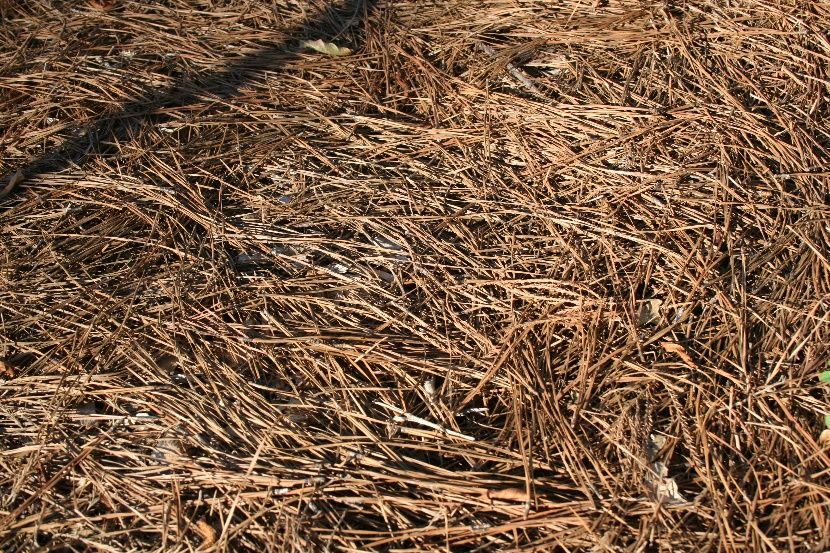
Credit: Florida-Friendly Landscaping™
- Fallen leaves and grass clippings—Fallen leaves and grass clippings are free from your yard. They can be gathered and raked under trees and into shrub beds. Large leaves may need to be mulched using a lawnmower or shredder to prevent matting. Leaves and grass clippings are high in nutrients but settle and decompose quickly and often need to be replenished.
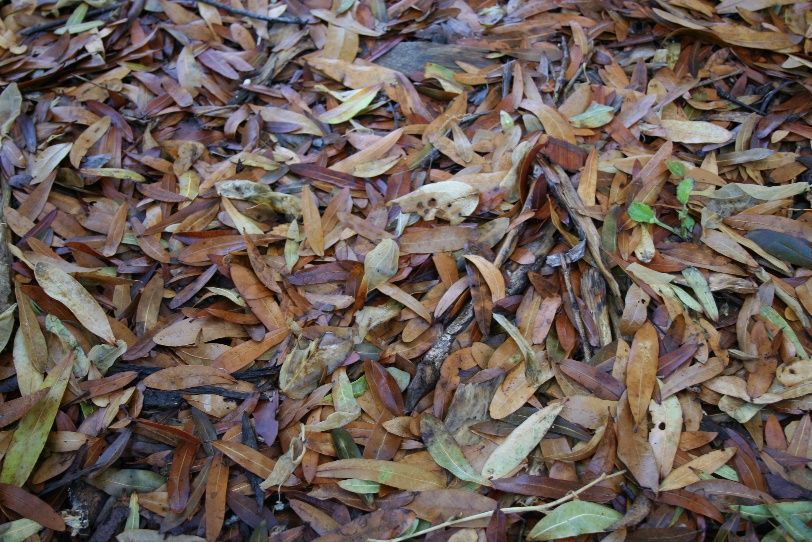
Credit: Florida-Friendly Landscaping™
- Melaleuca—The melaleuca tree is invasive in Florida and is a preferred source for mulch. Commercially sold melaleuca mulch has been cured at high temperatures to kill any seeds. Its appearance is that of mixed hardwood or cypress. It is slow to settle, meaning that it will last a long time. One UF/IFAS study found it more durable than pine bark and cypress (Duryea and Minogue 2017).
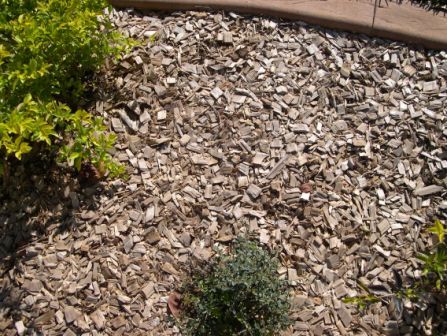
Credit: Florida-Friendly Landscaping™
- Eucalyptus—Eucalyptus mulch comes from trees grown specifically for mulch on plantations in south and central Florida. It is a fast-growing wood, so it is considered a renewable resource. It is less durable than cypress but more durable than utility mulch or pine straw (Duryea and Minogue 2017).
- Artificially colored mulches—The problem with colored mulch is the source of the wood, not the dye. Most colored mulch is dyed using organic colorants such as iron or carbon. However, colored mulch is generally made using two material sources: hardwood or recycled building materials and site-clearing debris. Colored mulch made of recycled building materials and site-clearing debris could be contaminated or treated with chromated copper arsenate, or CCA, from pressure-treated lumber. This substance is toxic to humans and animals, and mulch containing it should be avoided, especially in any vegetable garden. Proper personal protection equipment should be used when spreading it. Do not use colored mulch unless certified with the MSC Certification Logo, which denotes that the product is free of CCA-treated wood.
Do not use:
- Cypress—While some cypress mulch is the by-product of cypress harvested for lumber and used in fencing and flooring, its origin is often difficult to determine and it could come from Florida's ecologically sensitive forested wetlands. For this reason, FFL does not recommend it. Cypress mulch does not have a certification guaranteeing that it is a by-product or sustainably harvested.
- Inorganic—Inorganic mulch includes pebbles, stones, and rubber mulch. The FFL program does not recommend these mulches in plant beds because they don't add nutrients to the soil like organic mulch products. Inorganic mulches need constant attention to keep clean from dirt and leaves. In addition, rubber mulch absorbs heat leading to high temperatures in the ground beneath. Some UF/IFAS staff are also concerned about the toxicity of the degrading rubber. If inorganic mulches are chosen for pathways, make sure to use an underlayment to prevent leaching into the sandy soils.
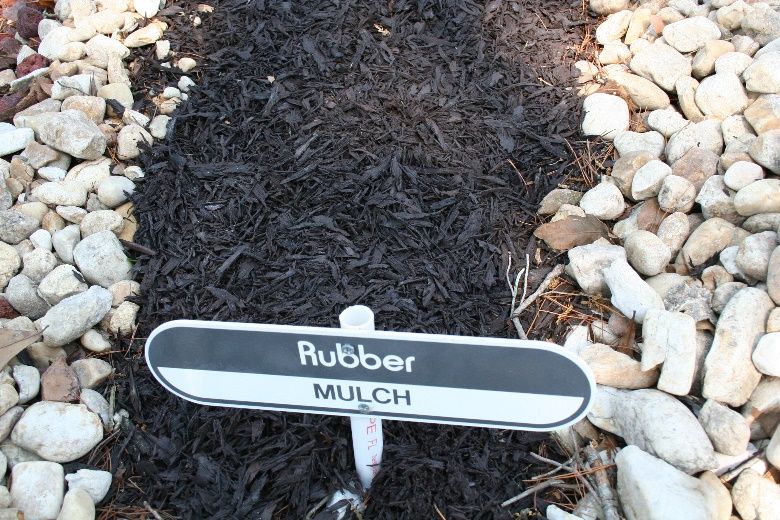
Credit: Florida-Friendly Landscaping™
Table 1. A comparison of mulches commonly available in Florida.
How Much to Buy
While it is convenient to purchase mulch by the bag (which commonly contains two cubic feet), it is often more cost-effective to buy mulch by the cubic yard. There are 27 cubic feet in a cubic yard, which is roughly 14 bags. At a 3-inch depth, one cubic foot of mulch will cover a four square foot area, and a two cubic foot bag will cover about eight square feet. Measure the area needing to be covered by using the following method.
Rectangular areas: Multiply the length (L) of the planting bed by the width (W). Example: 5 feet long × 10 feet wide = 50 square feet to cover.
Circular areas: Measure the distance from the circle's center to its edge. This is the radius of the circle. Multiply the radius by the radius again, then multiply the answer by 3.14. Example: 5 feet from the center to the edge × 5 × 3.14 = 78.5 square feet to cover.
Irregular areas: Estimate these areas by dividing them into circles and rectangles. Add the smaller areas together to estimate the whole.
Once you know the number of square feet of area you want to cover, multiply it by the number of inches of desired mulch depth, then divide this number by 324 to convert it to the cubic yards of mulch needed for the project.
[Area to Cover (Sq. Feet) × Mulch Depth (inches)] ÷ 324 = Cubic Yards Mulch Needed
Example Calculation:
How many cubic yards of mulch do you need to cover a 130 square foot area to a depth of 3 inches? (130 × 3) / 324 = 1.2 cubic yards of mulch
How to Use Mulch
- Weed the area to be mulched before applying mulch.
- Maintain a layer of mulch 2–3 inches around trees, shrubs, and bedding plants. Coarse materials such as pine bark nuggets may be applied up to 3” deep, but they settle about an inch. Do not allow mulch to remain at more than 3” deep, because the mulch intercepts and diverts rain and irrigation away from the underlying plant roots. Keep mulch uniform in depth.
- Do not mulch to the curb, sidewalk, or water's edge. Organic mulches eventually degrade and release nutrients that may wash away into storm drains and water bodies. This is especially true in sloped areas. If possible, use a buffer of grass or ground cover next to the hardscape. On downslopes, use groundcovers or grass so that mulch doesn't float away during rain.
- Avoid volcano mulching. Piling mulch against the trunk of a tree is called volcano mulching. It holds moisture and encourages rot in the trunk. It also creates a habitat for rodents, which tend to chew on the tender bark of trees and can kill them.
- Cover sides of the root ball with mulch. Keep mulch 12–18 inches from the trunk of any size tree. For aesthetic reasons, a thin, 1” layer of mulch can be placed over the root ball; otherwise, a thicker layer will block irrigation and rain from reaching the roots. Outside of the root ball, provide a 2-to-3-foot diameter circle of mulch per inch of tree trunk caliper. This will provide an adequately sized mulched area around the newly planted trees. Also, during establishment of the new tree, use the mulch, and herbicides if necessary, to keep turf as far away from the tree trunk as practical. The mulched area around the tree will also help prevent mower and string trimmer damage to the trunk and avoid soil compaction.
- Avoiding termites. Termites can be found in mulch, but their chances of survival is poor. The likelihood of termites surviving the chipping process used to create mulch is low, and once separated from the colony, their ability to survive decreases further.
- Mulch increases the ability of termites to survive where they are already established by keeping the soil moist and temperatures moderate. Mulch laid too thickly (>4–6 inches) can also provide a "bridge” over the treated perimeter of a house, allowing termites to crawl over from landscape to the house. Avoid contact with soil treated with termiticides. Apply a 12"-wide, thin border of mulch from the exterior house wall (<2 inches thick) to allow the soil beneath to naturally dry to deter termites (Oi 2006).
- In a study of inorganic (gravel) versus organic (bark and wood) mulches, Chalker-Scott (2007) noted that subterranean termites were found in greater numbers beneath gravel mulch. The wood and bark mulches were found to be unappealing to termites. In fact, termites fed a diet of wood and bark in a laboratory setting had a higher mortality rate (Chalker-Scott 2007).
Summary
Mulch, sustainably sourced and appropriately used, is an integral component of a Florida-friendly landscape. Appropriate mulches add to the nutritional composition of the soil, retain water, regulate soil temperatures, and contribute to the beauty of the landscape. This document provides a guide to help choose the most appropriate mulch for the different microenvironments that may be a home landscape, providing insights into variabilities in cost, color, durability, origin, texture, and appearance. This document also provides guidance in the proper application of mulch. If you have questions regarding mulch in your landscape, contact your local UF/IFAS Extension office for assistance.
References
Chalker-Scott, Linda. 2007. “Impact of Mulches on Landscape Plants and the Environment—A Review.” Journal of Environmental Horticulture 25 (4): 239–249. https://doi.org/10.24266/0738-2898-25.4.239
Duryea, M. L., and P. J. Minogue. 2017. “Landscape Mulches: How Quickly Do They Settle?” EDIS 2017 (3). https://edis.ifas.ufl.edu/publication/FR052
Florida-Friendly Landscaping™ Handbook for Home Landscaping. 2022. Florida-Friendly Landscaping™ Program.
Oi, Faith. 2006. “The Facts about Termites and Mulch.” EDIS 2006 (6). https://doi.org/10.32473/edis-in651-2006
UF/IFAS Gardening Solutions. 2021. “Choosing and Installing Mulches.” https://gardeningsolutions.ifas.ufl.edu/care/planting/mulch/